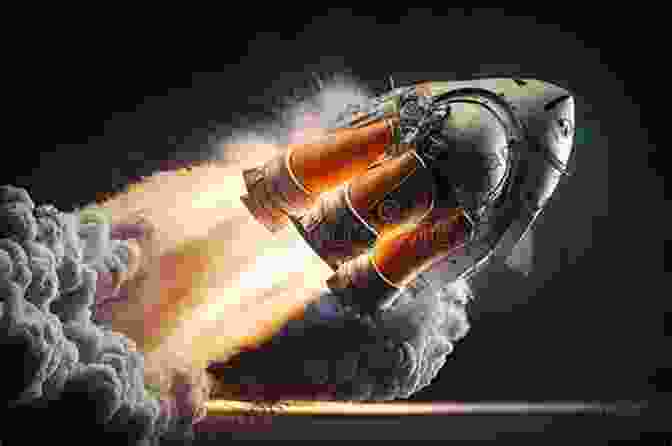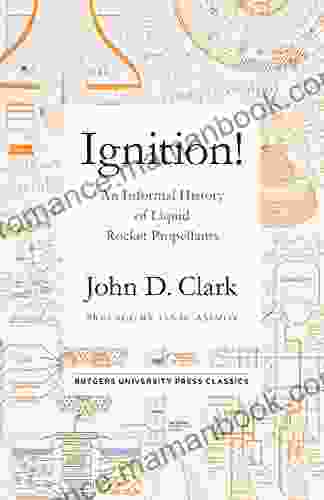Ignition: An Informal History of Liquid Rocket Propellants


Liquid rocket propellants are the fuels and oxidizers that are used to power liquid-fueled rockets. These propellants are typically stored in separate tanks and then mixed together in a combustion chamber, where they react to produce hot gases that are expelled through a nozzle to generate thrust.
4.7 out of 5
| Language | : | English |
| File size | : | 3521 KB |
| Text-to-Speech | : | Enabled |
| Screen Reader | : | Supported |
| Enhanced typesetting | : | Enabled |
| X-Ray | : | Enabled |
| Word Wise | : | Enabled |
| Print length | : | 302 pages |
The history of liquid rocket propellants dates back to the early days of rocketry. In the early 19th century, the British scientist William Congreve developed a series of rockets that used a mixture of alcohol and turpentine as fuel. In the late 19th century, the Russian scientist Konstantin Tsiolkovsky proposed using liquid oxygen and hydrogen as rocket propellants. However, it was not until the early 20th century that liquid rocket propellants were successfully used to power a rocket.
The first successful liquid-fueled rocket was the German V-2 rocket, which was developed during World War II. The V-2 rocket used a mixture of alcohol and liquid oxygen as propellants. After World War II, the United States and the Soviet Union began to develop their own liquid-fueled rockets. In the 1950s, the United States developed the Redstone rocket, which was used to launch the first American satellite into orbit. In the 1960s, the Soviet Union developed the Soyuz rocket, which was used to launch the first human into space.
Today, liquid rocket propellants are used to power a wide variety of rockets, including launch vehicles, space probes, and satellites. There are many different types of liquid rocket propellants, and each type has its own advantages and disadvantages.
Types of Liquid Rocket Propellants
There are two main types of liquid rocket propellants: fuels and oxidizers. Fuels are the substances that burn to produce hot gases. Oxidizers are the substances that provide the oxygen needed for combustion.
The most common type of fuel used in liquid rocket propellants is kerosene. Kerosene is a hydrocarbon that is derived from petroleum. It is a relatively inexpensive fuel, and it has a high energy density. Other fuels that are used in liquid rocket propellants include alcohol, hydrogen, and methane.
The most common type of oxidizer used in liquid rocket propellants is liquid oxygen. Liquid oxygen is a cryogenic liquid that is stored at very low temperatures. It is a very powerful oxidizer, and it has a high specific impulse. Other oxidizers that are used in liquid rocket propellants include hydrogen peroxide, nitric acid, and fluorine.
Advantages and Disadvantages of Liquid Rocket Propellants
Liquid rocket propellants have several advantages over other types of rocket propellants. First, liquid propellants are relatively easy to store and transport. Second, liquid propellants can be throttled, which means that the thrust of the rocket can be adjusted while it is operating. Third, liquid propellants have a high energy density, which means that they can produce a lot of thrust for a given amount of mass.
However, liquid rocket propellants also have some disadvantages. First, liquid propellants are cryogenic liquids, which means that they must be stored at very low temperatures. This can be a challenge, especially in space. Second, liquid propellants are flammable, which means that they can be dangerous to handle. Third, liquid propellants are relatively expensive.
Liquid rocket propellants have played a major role in the development of space exploration. These propellants are used to power a wide variety of rockets, including launch vehicles, space probes, and satellites. Liquid rocket propellants have several advantages over other types of rocket propellants, but they also have some disadvantages.
The future of liquid rocket propellants is uncertain. There are several new technologies that are being developed that could potentially replace liquid propellants. However, liquid propellants are likely to remain the dominant type of rocket propellant for the foreseeable future.
4.7 out of 5
| Language | : | English |
| File size | : | 3521 KB |
| Text-to-Speech | : | Enabled |
| Screen Reader | : | Supported |
| Enhanced typesetting | : | Enabled |
| X-Ray | : | Enabled |
| Word Wise | : | Enabled |
| Print length | : | 302 pages |
Do you want to contribute by writing guest posts on this blog?
Please contact us and send us a resume of previous articles that you have written.
 Top Book
Top Book Novel
Novel Fiction
Fiction Nonfiction
Nonfiction Literature
Literature Paperback
Paperback Hardcover
Hardcover E-book
E-book Audiobook
Audiobook Bestseller
Bestseller Classic
Classic Mystery
Mystery Thriller
Thriller Romance
Romance Fantasy
Fantasy Science Fiction
Science Fiction Biography
Biography Memoir
Memoir Autobiography
Autobiography Poetry
Poetry Drama
Drama Historical Fiction
Historical Fiction Self-help
Self-help Young Adult
Young Adult Childrens Books
Childrens Books Graphic Novel
Graphic Novel Anthology
Anthology Series
Series Encyclopedia
Encyclopedia Reference
Reference Guidebook
Guidebook Textbook
Textbook Workbook
Workbook Journal
Journal Diary
Diary Manuscript
Manuscript Folio
Folio Pulp Fiction
Pulp Fiction Short Stories
Short Stories Fairy Tales
Fairy Tales Fables
Fables Mythology
Mythology Philosophy
Philosophy Religion
Religion Spirituality
Spirituality Essays
Essays Critique
Critique Commentary
Commentary Glossary
Glossary Bibliography
Bibliography Index
Index Table of Contents
Table of Contents Preface
Preface Introduction
Introduction Foreword
Foreword Afterword
Afterword Appendices
Appendices Annotations
Annotations Footnotes
Footnotes Epilogue
Epilogue Prologue
Prologue David Grann
David Grann Eileen Riley Hall
Eileen Riley Hall Mia Middonte
Mia Middonte Raymond A Serway
Raymond A Serway Norma Budden
Norma Budden R Nelson Nash
R Nelson Nash Jonathan Clayden
Jonathan Clayden Bill Phillips
Bill Phillips William Brewer
William Brewer Xavier Amador
Xavier Amador David Whyte
David Whyte Annajo Janisz
Annajo Janisz Hugh Ryan
Hugh Ryan Edward L Zuckerman
Edward L Zuckerman Felipe M S Silva
Felipe M S Silva Barbara Liedahl
Barbara Liedahl Danny Lenihan
Danny Lenihan Marc Macyoung
Marc Macyoung Dennis Machino
Dennis Machino John Heart
John Heart
Light bulbAdvertise smarter! Our strategic ad space ensures maximum exposure. Reserve your spot today!

 Branden SimmonsBatsford's 'Chess for Children' Activity: An Engaging Educational Experience...
Branden SimmonsBatsford's 'Chess for Children' Activity: An Engaging Educational Experience...
 Greg FosterFiring Line: The Silencer 17: A Comprehensive Guide to the Precise and Lethal...
Greg FosterFiring Line: The Silencer 17: A Comprehensive Guide to the Precise and Lethal... Jimmy ButlerFollow ·12.4k
Jimmy ButlerFollow ·12.4k George BellFollow ·14.6k
George BellFollow ·14.6k Quincy WardFollow ·4.4k
Quincy WardFollow ·4.4k Rodney ParkerFollow ·15.6k
Rodney ParkerFollow ·15.6k Ernest ClineFollow ·3k
Ernest ClineFollow ·3k Joshua ReedFollow ·7.8k
Joshua ReedFollow ·7.8k Forrest ReedFollow ·18.5k
Forrest ReedFollow ·18.5k Charles ReedFollow ·15.5k
Charles ReedFollow ·15.5k

 Jared Nelson
Jared NelsonThe Da Vinci Code: A Literary Odyssey into the World of...
A captivating image of The Da Vinci Code...

 Harvey Bell
Harvey BellJohn Pearce: An Action-Packed Maritime Adventure
Join John...

 Ken Follett
Ken FollettSky Dragons: Unveiling the Majestic Creatures from the...
In the ethereal world of Anne McCaffrey's...

 Blake Bell
Blake BellEasy And Delicious Baking Recipes You Can Effortlessly...
Baking can be a great way to relax and...

 Maurice Parker
Maurice ParkerUnveiling the Profound Insights and Lyrical Beauty of...
In the realm of contemporary poetry, "Growl...
4.7 out of 5
| Language | : | English |
| File size | : | 3521 KB |
| Text-to-Speech | : | Enabled |
| Screen Reader | : | Supported |
| Enhanced typesetting | : | Enabled |
| X-Ray | : | Enabled |
| Word Wise | : | Enabled |
| Print length | : | 302 pages |










